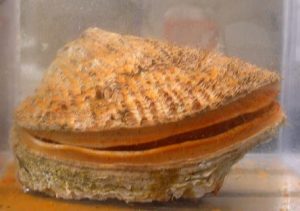
Considerable commercial interest exists in rock scallop purple hinged rock scallop (Crassadoma gigantea) aquaculture throughout its native range along the west coast of the United States. The rock scallop is an ideal new aquaculture species with several advantages over other prospective species. First, rock scallops can be cultured in all existing west coast aquaculture environments,
including nearshore and offshore/open-ocean locations along the entire west coast from Baja California to southeastern Alaska. While southern Californian scallops grow faster than other populations, market sized scallops could be produced in 2-4 years throughout their range. Second, a strong market potential exists for this species. The rock scallop is highly prized among west coast sport divers, but commercial harvest is prohibited throughout its range primarily due to a very patchy distribution and consequent susceptibility to overharvesting. Importantly, because commercial harvest of this species is prohibited, there will be no direct competition between a fishery and cultured product. However, unintentional spawning of hatchery-bred scallops in the wild may affect genetic diversity of wild populations, thus potentially reducing the extent of local adaptation and the potential to respond to anthropogenic environmental change.
Through our collaborative approach, we support the development of rock scallop aquaculture by developing an integrative framework to evaluate the potential effects of hatchery derived rock scallops on wild stocks. We are investigating the extent of local adaptation in the wild in an interdisciplinary approach involving reciprocal transplant experiments, genome scans of wild populations, and experiments assessing differential gene expression under ocean acidification. Recognizing that, despite our high resolution empirical approach, we may miss a signal of local adaptation, we will also use our novel data to inform a state of the art predictive risk model that can inform aquaculture operation and management.
Researchers: Natalie Lowell (PhD student), Molly Jackson (MS student, Taylor Shellfish)
Collaborators: Brent Vadopalas (SAFS), Joth Davis (Taylor Shellfish, Baywater Inc., Puget Sound Restoration Fund), Brady Blake (WDFW).
Funding: NOAA National Sea Grant Aquaculture Program, Western Regional Aquaculture Center